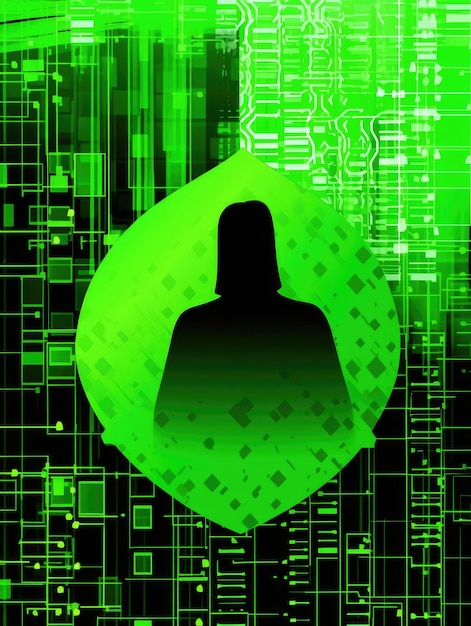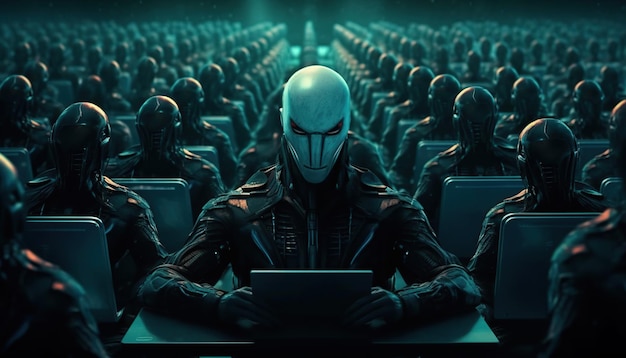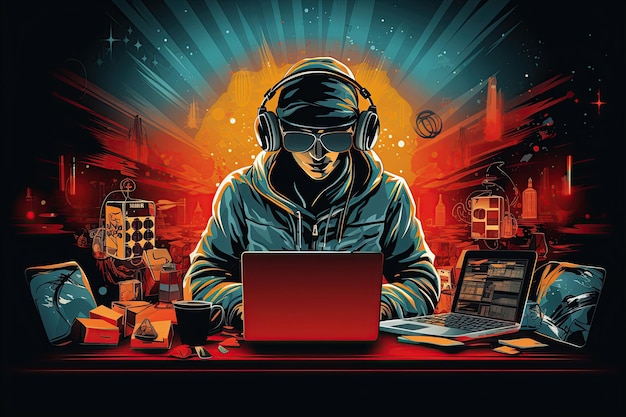Quick Read
11 Notorious Hackers in History: Their Motives, Methods, and Impact on Cybersecurity
Throughout history, hacking has been both a source of innovation and a major threat to cybersecurity. While some hackers use their skills for good, others have caused significant damage to organizations and individuals. In this article, we will explore the stories of 11 notorious hackers, examining their motivations, methods, and the impact they’ve had on cybersecurity.
Kevin Mitnick
Kevin Mitnick, also known as the “World’s Most Wanted Hacker,” gained notoriety in the late 1980s and early 1990s. He was a social engineer, using his charm and persuasive abilities to gain access to confidential information.
Motives
Mitnick hacked for the thrill and challenge. He saw it as a game, with no malicious intent.
Methods
Mitnick used social engineering techniques, such as phone pretexting and e-mail phishing, to gain unauthorized access to computer systems.
Impact
Mitnick’s arrest in 1995 marked the end of an era for hacking. The case brought attention to the issue of cybersecurity and led to increased efforts to protect against social engineering attacks.
I. Introduction
Hacking, a term once synonymous with mischievous activities in the early days of computing, has now evolved into a complex and critical issue in the digital age. Hacking itself is a dynamic concept, encompassing various practices from harmless explorations to malicious attacks. A brief overview of hacking’s historical significance sheds light on its evolution and the importance of understanding this history in shaping cybersecurity.
Brief Overview of Hacking and its Historical Significance
The roots of hacking can be traced back to the 1950s and 1960s when early computer enthusiasts, known as “hackers,” discovered joy in exploring the limits of their systems. They engaged in activities like writing simple programs, testing system security, and sharing knowledge with each other. This era marked the birth of the hacking culture that emphasized learning, creativity, and innovation.
The Golden Age of Hacking (1960s-1980s)
During this period, hacking thrived as computer clubs and bulletin boards became popular platforms for sharing knowledge. Hackers focused on understanding the inner workings of systems, pushing boundaries, and creating tools to automate repetitive tasks. These early hackers set the foundation for modern cybersecurity by identifying vulnerabilities long before they were exploited maliciously.
The Dark Side of Hacking (1980s-Present)
As technology advanced, so did the potential for malicious hacking. In the late 1980s, hacking took a darker turn when motivated by financial gain or political agendas. Hackers began to exploit vulnerabilities for personal profit, causing significant damage to organizations and individuals. This shift forced the cybersecurity industry to evolve and adapt to counteract these threats.
Importance of Understanding the History of Hacking in Shaping Cybersecurity
Understanding the history of hacking is crucial in shaping cybersecurity for several reasons:
Acknowledgement of the Origins of Hacking
Recognizing the origins of hacking as a culture that promoted learning and innovation helps us appreciate its transformative potential. This understanding allows us to separate the ethical hackers from the malicious actors, which is essential in addressing cybersecurity threats.
Lessons Learned from Past Vulnerabilities
By studying the historical evolution of hacking, we can learn valuable lessons about past vulnerabilities and how they were exploited. This knowledge enables us to develop better strategies for identifying and mitigating future threats.

The Early Pioneers: 1950s-1980s
During the 1950s-1980s, a new era of computer technology emerged, marked by the pioneering work of visionaries and innovators. This period saw the birth of the digital revolution, which transformed the way we live, work, and communicate.
IBM’s Early Dominance
IBM (International Business Machines), the American multinational technology company, was a major player in this early era. IBM’s System/360 mainframe computer series, introduced in 1964, was a significant milestone. This system was designed to be upwardly compatible—meaning new models could run older software. IBM’s commitment to compatibility ensured that customers would not need to replace their entire system each time they upgraded, making it a commercial success.
Birth of Personal Computing
The 1970s marked the inception of personal computing. The first commercially successful personal computer, the Altair 8800, was introduced in 1975. This machine, which could be assembled from a kit, ignited the interest of hobbyists and entrepreneurs alike. A young Bill Gates, co-founder of Microsoft, wrote the BASIC programming language for the Altair. This move secured Microsoft’s position as a leading software provider for personal computers.
Apple’s Game-Changing Innovation
In 1976, Steve Jobs and Steve Wozniak founded Apple Computer Inc. Their innovative product, the Apple II, was introduced in 1977. With its color graphics, open architecture, and easy-to-use interface, the Apple II revolutionized the personal computer market. This machine paved the way for the Macintosh, which in turn popularized the graphical user interface (GUI) and mouse.
Other Key Players
Several other companies contributed to this era’s technological advancements. DEC (Digital Equipment Corporation) introduced the PDP-8 mini-computer in 1965, which was widely used for educational and research purposes. In 1972, Xerox PARC (Palo Alto Research Center) developed the first WYSIWYG (What You See Is What You Get) text editor and the first computer mouse. These inventions later influenced Apple’s Macintosh design.
Impact on Modern Technology
The pioneering work of these early visionaries laid the groundwork for modern technology. Their innovations in computer hardware and software set the stage for further advancements, leading to the widespread use of personal computers, the internet, and other digital technologies that continue to shape our world.

Steve Wozniak and Steve Jobs: The Pioneering Duo Behind the Apple I
Background and Motivation:
Steve Wozniak
– a prolific inventor, electronics wizard, and founder of Apple Computer Inc., began his journey in the early 1970s as a hardware hacker. Wozniak’s motivation was simple: a passion for technology and an innate desire to create innovative solutions. His brilliance lay in his ability to design and build Hewlett-Packard calculator clones, which were sold among fellow tech enthusiasts.
Steve Jobs
– the charismatic visionary co-founder of Apple, joined Wozniak in 1975. With a strong belief in the potential for personal computers to change the world, Jobs focused on marketing and business strategies while Wozniak handled hardware design.
Methods: Hardware Hacking
In the mid-1970s, the duo worked tirelessly to create the Apple I:
Wozniak
– designed and built the Apple I computer using his expertise in hardware hacking and reverse engineering. He created a simple yet revolutionary design that was easy to assemble and included an innovative method for input/output using the Cassette Interface. This allowed users to store and load programs using audio cassettes.
Jobs
– leveraged his sales skills to secure components from distributors at lower prices, allowing Apple to offer the Apple I at a competitive price. He also focused on marketing efforts, which included setting up retail channels and targeting key customers.
Impact on Cybersecurity and Technology Industry
The Apple I was the first successful personal computer built in the garage, paving the way for a new era of technology. Its impact on cybersecurity and the tech industry can be seen in numerous ways:
Personal Computing
– Apple I’s success led to the popularization of personal computers, which would eventually revolutionize industries and change the way people communicated and worked.
Hardware Hacking and Innovation
– Wozniak’s approach to hardware hacking and tinkering inspired a new generation of inventors, entrepreneurs, and tech enthusiasts.
Cybersecurity
– the Apple I’s open architecture presented an early challenge for cybersecurity, forcing users to take proactive measures against malware and other threats. This set the stage for ongoing efforts in securing personal computers.
Kevin Mitnick: The Condor – Master Hacker
Born on August 6, 1963, Kevin Mitnick, also known as “The Condor,” began his hacking career out of pure curiosity and a desire to understand the limitations of computer systems. Mitnick’s interest in social engineering started as a teenager when he would call companies posing as technicians, manipulating employees into providing sensitive information over the phone.
Background and Motivation: Curiosity and Social Engineering
Mitnick’s early experiences with social engineering set the foundation for his innovative approach to hacking. Intrigued by phone systems, he became a phone phreaker – exploring telephone networks and developing techniques to make free long-distance calls. His curiosity expanded beyond phone systems to include computer networks, leading him to become one of the first known war dialers, scanning for vulnerabilities in thousands of systems.
Methods: Social Engineering, Phone Phreaking, and War Dialing
Social Engineering:
Mitnick’s social engineering techniques were far ahead of their time. He would cold call employees at target organizations, posing as IT support or executives to gain access to sensitive information and systems. By building trust and using psychological manipulation, Mitnick was able to bypass security measures that relied on technology alone.
Phone Phreaking:
Mitnick’s phone phreaking skills allowed him to gain unauthorized access to telephone systems, a significant accomplishment in the early days of telecommunications. He could create free long-distance calls, listen in on conversations, and even tap into private phone lines.
War Dialing:
War dialing was a novel technique used by Mitnick to discover connected computers and their vulnerabilities. Using automated tools, he would scan for computers with open ports and weak security configurations. This process allowed him to identify potential targets and plan his attacks carefully.
Impact on Cybersecurity: Creation of the Federal Communications Commission’s Computer Emergency Response Team (CERT) and the Passage of Anti-Hacking Laws
Mitnick’s exploits caught the attention of law enforcement and raised public awareness about computer security. The Federal Communications Commission (FCC) responded by establishing the Computer Emergency Response Team (CERT) to help organizations respond to cybersecurity threats. Additionally, Congress passed several anti-hacking laws in response to Mitnick’s activities, including the Computer Fraud and Abuse Act (CFAA) and the Electronic Communications Privacy Act (ECPA).
References:
I The Masters of Malware: 1980s-Present
From the late 1980s onwards, a new breed of cybercriminals emerged, known as masters of malware. These individuals and groups took malicious software (malware) creation to unprecedented levels, often with devastating consequences.
Morris Worm: An Early Precursor (1988)
One of the earliest and most notable examples is the Morris Worm, which hit the Internet in November 1988. Robert Morris, a graduate student at Cornell University, unintentionally released this self-replicating program as a means of measuring the Internet’s size. Unfortunately, it quickly spread beyond its intended scope, infecting tens of thousands of computers and crippling networks for days or even weeks.
Elk Cloner: The First Known Mac Virus (1982)
Another early malware event was the creation of the first known Macintosh virus, Elk Cloner, in 198Designed as a prank, it was distributed on floppy disks and would infect Apple computers when they booted up, displaying a message and requiring the user to type “4242” as a password. This was a significant milestone in malware history, showing that no platform was immune to such threats.
Creeper and Reaper: The First Computer Viruses (1970s)
The 1980s also saw the popularization of viruses like Creeper and Reaper, which were first created in the late 1970s. These programs were designed to spread throughout ARPANET (the precursor to the Internet) by infecting files and leaving a message, often a simple “I’m the creeper: catch me if you can!” Creeper was harmless but Reaper, its counterpart, would delete infected files upon rebooting the system.
Virus Writers and Hackers: The Underground Scene
Throughout the 1980s and beyond, there existed an underground scene of virus writers and hackers. Some did it for notoriety, while others sought financial gain or merely to challenge themselves. Regardless of their motivations, these individuals left a profound impact on the world of cybersecurity and set the stage for more sophisticated malware attacks to come.

Robert Morris: The Man Behind the First Computer Worm
Background and motivation:
Born on March 25, 1965, in Pittsburgh, Pennsylvania,
Methods:
In 1988, while working as a graduate student at Carnegie Mellon University (CMU), Morris created the first computer worm, known as the
Impact on cybersecurity:
The Morris Worm resulted in an estimated 6,000 infected systems and caused approximately $10 million in damages. The incident served as a wake-up call for the need to improve internet security and introduced computer ethics into the discussion. It also led to significant legal developments, such as the
Defense Against Intrusions Act
in 1996, which allowed hacking for security research purposes. Although controversial at the time, these events have significantly influenced the evolution of cybersecurity and continue to shape our digital landscape today.
Michael Tsai: The Mastermind Behind Elk Cloner and Dark Avenger
Michael Tsai, a brilliant and enigmatic computer enthusiast, gained notoriety in the late 1980s for creating two groundbreaking malware programs: Elk Cloner and Dark Avenger. Tsai’s primary motivation for creating these viruses was a combination of
revenge
,
curiosity
, and a
challenge
to outwit the burgeoning cybersecurity community.
In his quest for innovation, Tsai created
Elk Cloner
, the first known Macintosh computer virus, in 198Elk Cloner was designed as a boot sector virus, meaning it would infect the floppy disk and spread to other computers upon transfer. Once executed, the virus displayed a humorous poem on the user’s screen before replicating itself. Despite its playful nature, Elk Cloner was a significant milestone in cybersecurity history as it exposed the vulnerabilities of Apple’s newly launched operating system.
The impact of Tsai’s Elk Cloner virus on cybersecurity was profound, leading to a heightened awareness among computer users and the development of antivirus software. In response,
Symantec
, a leading cybersecurity company, created the first Macintosh antivirus solution,
Macintosh VirusScan
, to counteract the threat. Furthermore, Elk Cloner set the stage for the evolution of malware, driving researchers and cybersecurity professionals to remain vigilant against new threats.
Tsai’s second creation,
Dark Avenger
(continued below), was even more sophisticated and destructive. By combining both file infector and boot sector virus techniques, Dark Avenger spread rapidly between Macintosh computers. It would overwrite specific system files and display a menacing message: “Your Mac is now under the control of Dark Avenger.” Although Tsai eventually disclosed the vulnerabilities he had exploited to create these viruses, his actions undeniably shaped the cybersecurity landscape and laid the foundation for the ongoing battle against malware.
Kevin Poulsen (Dark Dante): The Early Cyber Criminal
Kevin Poulsen, also known as Dark Dante,, is a former hacker who gained notoriety in the late 1980s and early 1990s. Born in New York City, Poulsen grew up with a
curiosity
for technology and a knack for social engineering and pranks. He began his hacking career by exploring the
phone phreaking
scene, using techniques to manipulate telephone systems for free long-distance calls. Poulsen’s motivation was more about the thrill of the challenge than any monetary gain.
One of Poulsen’s most famous exploits was
war dialing
, a process of systematically scanning IP addresses for vulnerabilities. In 1989, he used this method to gain unauthorized access to the Los Angeles Police Department’s computer system. Known as “Max Headroom,” Poulsen replaced the normal emergency alert message with a video of the fictional character Max Headroom, causing panic and confusion in the city.
Another major hack attributed to Poulsen was the attempted theft of phone numbers from Pacific Bell. Known as “The 2600 Hack,” this prank targeted a computer used by the company to assign phone numbers, which could have potentially caused significant disruption in the telephone network. Although Poulsen did not successfully carry out this hack, it brought increased attention to
cybersecurity
issues and the vulnerabilities of phone systems.
Poulsen’s actions eventually led to the creation of the
Computer Fraud and Abuse Act (CFAA)
in 1986, making it a federal crime to access a computer without authorization or to exceed authorized access. The passage of the CFAA marked a turning point in the history of cybercrime and established legal frameworks for dealing with hacking incidents.
The Corporate Espionage King: 1980s-Present
Michael “The Ghost” Buttner, a notorious figure in the corporate world, rose to fame as the Corporate Espionage King during the 1980s and continued his reign through the present day. His covert operations, often involving the infiltration of rival companies‘ trade secrets, brought him both fortune and infamy.
Background
Born in 1952, Buttner began his career as an intelligence analyst for the U.S. Military Intelligence Agency. There, he honed his skills in gathering sensitive information and uncovering enemy strategies. After leaving the military, he transitioned to the corporate sector where he found a lucrative market for his talents.
Tactics
Buttner’s tactics were simple yet effective: he employed a team of skilled operatives, each with a specific role in the espionage process. His agents were experts in disguise, able to blend seamlessly into their target environments. Infiltrators gained access to confidential information through various means, such as posing as janitors or security guards. Exfiltrators, once the data was obtained, would remove it from the premises undetected. Buttner’s team was a well-oiled machine, and they left no stone unturned in their pursuit of valuable corporate intelligence.
Legacy
Buttner’s impact on the business world was significant. His espionage activities led to numerous multimillion-dollar deals and provided valuable competitive advantages for his clients. However, his actions also raised ethical concerns, sparking debates about the morality of corporate espionage and its potential consequences. Despite these discussions, Buttner’s legacy as the Corporate Espionage King endured, inspiring a new generation of business spies.

Kevin Mitnick (Return of the Condor)
Background
Born on August 6, 1963, Kevin Mitnick started his hacking career out of a desire for revenge, challenge, and financial gain. Mitnick was a social outcast in his teenage years, often feeling isolated and misunderstood. He discovered the world of computer hacking as a way to connect with others and prove his abilities. By the late 1980s, Mitnick had gained a reputation as one of the most elusive and skilled hackers in the world.
Methods
Social Engineering: Mitnick’s primary method of attack was social engineering. He would use his charisma and charm to trick people into revealing sensitive information over the phone. His ability to impersonate authority figures and gain the trust of unsuspecting victims made him a formidable adversary.
War Dialing
Another technique Mitnick used was war dialing. This involved scanning large networks of computers for vulnerabilities. By identifying weak points in a network, Mitnick could gain unauthorized access to sensitive information.
Hacking into Corporate Networks
Once Mitnick had identified a vulnerability, he would use hacking tools to breach the network’s security. He was known for his ability to remain undetected for long periods of time, often going unnoticed for months. Mitnick’s attacks were not only sophisticated but also targeted specific individuals and organizations, causing significant damage.
Impact on Cybersecurity
Mitnick’s exploits brought cybersecurity into the public spotlight. His arrest in 1995 marked a turning point in the fight against cybercrime. Corporations began to strengthen their security measures, implementing firewalls, intrusion detection systems, and other protective technologies.
Public Awareness
The case also raised awareness about the importance of securing sensitive information. People began to take their online security more seriously, using stronger passwords and being more cautious when sharing information over the phone or email.
Conclusion
Kevin Mitnick’s story is a reminder of the importance of cybersecurity and the dangers posed by sophisticated hackers. Despite his criminal activities, Mitnick’s legacy has helped shape the modern cybersecurity landscape.

The Anonymous Collective: A Hidden Force in Cyberspace
The Anonymous Collective, also known as simply Anonymous, is an
international
hacktivist collective known for using
methodical
methods and the
anonymity
provided by the
Tor network
to carry out both
cyber attacks
and
online activism campaigns
. This decentralized group, which has no formal leadership or hierarchical structure, is estimated to have thousands of individual members, making it a formidable force in the digital realm.
The origins of Anonymous can be traced back to 2003, when a group of individuals on the
4chan
imageboard adopted the name as a joke. Over time, however, this loose affiliation of pranksters grew into a larger movement, with members organizing themselves around shared causes. Some of the group’s earliest campaigns targeted entities perceived as oppressive or corrupt, including the Church of Scientology and the United States government.
Anonymous operates through a decentralized, leaderless structure that relies on the actions of individual members. This means that there is no single point of failure and no clear chain of command. Instead, Anonymous uses
encrypted communication channels
and relies on a culture of shared ideals to coordinate actions. While this lack of formal structure makes it difficult to fully understand the collective’s activities, it also makes it resilient and adaptable.
Origin and Motivation: Political Activism and Cyber Warfare
Political activism and cyber warfare have emerged as significant issues in the digital age. Political activism, also known as political hacktivism, refers to the use of technology to advance political or social causes. This can include anything from creating and spreading awareness through social media campaigns to hacking websites to make a political statement. On the other hand, cyber warfare, also known as cyber espionage or cyber terrorism, is the use of technology to disrupt or damage enemy infrastructure. Both activities have their origins in the late 20th century but have gained significant momentum in recent years.
Motivation
The motivation behind political activism and cyber warfare varies greatly. In the case of political activism, individuals or groups may be driven by a desire to bring about social change, promote a cause, or challenge existing power structures. Cyber warfare, on the other hand, is often driven by national interests, political ideologies, or economic gain.
Methods: Distributed Denial of Service (DDoS) Attacks, Hacking, and Social Media Campaigns
The methods used in political activism and cyber warfare are diverse and constantly evolving. Some common tactics include:
Distributed Denial of Service (DDoS) Attacks
DDoS attacks involve overwhelming a website or server with traffic in order to make it unavailable to users. This can be done through botnets, which are networks of compromised computers that can be used to generate traffic.
Hacking
Hacking refers to the unauthorized access, use, disclosure, modification, or destruction of information from a computer system. Hackers may be motivated by financial gain, curiosity, or political reasons.
Social Media Campaigns
Social media campaigns involve using social media platforms to spread information, rally support, or manipulate public opinion. These campaigns can be used for both political activism and cyber warfare.
Impact on Cybersecurity: Increased Awareness of the Importance of Cybersecurity in Political Contexts and the Need for Stronger Legislation Against Cyber Attacks
The impact of political activism and cyber warfare on cybersecurity has been significant. These activities have highlighted the need for stronger legislation against cyber attacks, as well as increased awareness of the importance of cybersecurity in political contexts. Some countries have even established cyber warfare units within their military forces.
Increased Awareness
The increased use of technology in politics has led to a greater awareness of the importance of cybersecurity. Politicians, activists, and organizations are increasingly recognizing the need to protect their digital infrastructure from cyber attacks.
Stronger Legislation
Governments around the world are responding to the threat of cyber warfare by enacting stronger legislation. For example, the United States passed the Cybersecurity Act of 2015, which established a framework for improving cybersecurity in critical infrastructure sectors.
VI. The State-Sponsored Hackers: 1990s-Present
Since the late 1990s, state-sponsored hacking has emerged as a significant threat to cybersecurity. Government agencies and militaries around the world have been engaging in clandestine activities, using hackers to gain intelligence, disrupt adversaries, and assert political control. The
Chinese
government is one of the most notorious state sponsors of hacking. In 2013, it was revealed that the National Security Agency (NSA) of the
United States
had been monitoring Chinese hacking activity for years. However, China was not alone in these activities. Other governments, including
Russia
,
North Korea
, and
Iran
, have also been accused of sponsoring hacking campaigns.
Motivations for State-Sponsored Hacking
State-sponsored hacking can serve several purposes. One primary motivation is to gather intelligence. By hacking into networks, governments can learn about their adversaries’ capabilities, intentions, and vulnerabilities. This information can be used for strategic planning and military advantage. Another motivation is to disrupt or damage adversaries’ infrastructure. Cyberattacks can cause economic damage, disrupt operations, and even threaten national security.
Tools and Techniques
State-sponsored hackers often employ sophisticated tools and techniques, such as zero-day exploits and advanced persistent threats (APTs). Zero-day exploits refer to vulnerabilities in software that are unknown to the software vendor. State-sponsored hackers can use these exploits to gain unauthorized access to systems before the vulnerabilities have been patched. APTs are long-term, targeted attacks that involve multiple stages of intrusion and exfiltration. These attacks can go undetected for months or even years.
Impact and Response
The impact of state-sponsored hacking can be significant. In 2010, Google reported that it had been the victim of a sophisticated cyberattack originating from China. The attack targeted the Gmail accounts of human rights activists and led to a public outcry about Chinese hacking activities. In response, the United States and other countries expelled Chinese diplomats and imposed sanctions. However, state-sponsored hacking continues to pose a significant threat to cybersecurity, requiring ongoing vigilance and innovation in the field.

Aldrich Ames: The Walk-In Spy
Background and Motivation:
Aldrich Ames, an American intelligence officer, is one of the most notorious spies in modern history. Born on July 27, 1941, Ames served in the Central Intelligence Agency (CIA) from 1963 to 1985. He was initially motivated by financial gain and personal reasons. Ames, who had a lavish lifestyle despite his modest income, grew discontent with his salary. Moreover, he harbored resentment against the CIA for perceived slights and was deeply in debt due to gambling and extramarital affairs.
Methods:
Ames began selling classified documents to the Soviet Union in late 1985, providing them with details about CIA sources and methods. He would steal documents from his office at the CIA’s Counterintelligence Center, where he worked as a case officer. Ames would photocopy or take detailed notes on the documents and then sell them to Soviet agents during their clandestine meetings.
Impact on Cybersecurity:
Ames’ betrayal exposed significant vulnerabilities in the CIA’s security protocols. His actions led to enhancement of encryption technologies and increased awareness of insider threats. Consequently, organizations worldwide began implementing stricter security measures to protect sensitive information from insiders.
Edward Snowden: The Prism Leaker
Edward Snowden, born on January 21, 1983, is a former Central Intelligence Agency (CIA) employee and National Security Agency (NSA) contractor who leaked classified information about extensive global surveillance operations to the media in 201Snowden’s actions exposed the NSA’s link program and initiated a global debate on the balance between national security and personal privacy.
Background and Motivation
Snowden grew up in Elizabeth City, North Carolina, and joined the United States Army after high school. He was honorably discharged due to injury. Snowden then pursued a career in information technology, first as a civilian employee with the NSA and later as a contractor for Booz Allen Hamilton. His concerns about government surveillance and privacy intensified after witnessing NSA’s massive data collection efforts under the FISA Amendments Act. He believed that such activities threatened individual privacy and civil liberties, especially when carried out without proper oversight.
Methods
In May 2013, Snowden stole thousands of classified documents detailing the NSA’s global surveillance programs and shared them with James R. Clapper Jr., Director of National Intelligence, requesting an investigation into the practices he believed were unconstitutional. When no action was taken, Snowden contacted journalists to reveal his identity and share the documents with them. The first reports appeared in The Guardian and The Washington Post, sparking an international controversy.
Impact on Cybersecurity
Snowden’s revelations led to a worldwide debate about government surveillance, privacy, and encryption technologies. Critics argue that mass data collection is necessary for national security, while proponents of privacy maintain that such activities threaten individual freedoms. The leaks also exposed vulnerabilities in various internet services and communication platforms, prompting companies to improve their encryption methods and heighten security awareness among users.
V Conclusion
In the annals of cybercrime, a select few notorious hackers have left indelible marks on the digital landscape. From Kevin Mitnick, the “Buggerman,” who famously hacked into NASA’s Jet Propulsion Laboratory and other high-profile targets, to Anonymous, the decentralized collective known for large-scale attacks on governments and corporations, these cybercriminals have demonstrated both the power and the peril of digital intrusion.
Recap of the Notorious Hackers and Their Impact on Cybersecurity
The stories of these hackers serve as stark reminders of the ever-evolving cyber threat landscape. Edward Snowden, who leaked classified documents revealing extensive government surveillance, exposed vulnerabilities in state security and sparked a global debate on privacy versus security. Stuxnet, a sophisticated malware created reportedly by the United States and Israel, targeted Iran’s nuclear program, demonstrating the potential for cyberweapons to cause physical damage.
Lessons Learned from History and Future Implications for Cybersecurity and Policy Development
These historical instances offer invaluable insights into the importance of robust cybersecurity measures and effective policy development. Firstly, it is crucial to recognize that cybercrime can have both digital and physical consequences, necessitating a holistic approach to security. Secondly, the anonymous nature of cyberspace requires international cooperation for effective response and prevention efforts. Lastly, the dynamic threat landscape demands ongoing vigilance and adaptation to emerging technologies and tactics.
Digital versus Physical Consequences
The interconnectedness of our digital world underscores the necessity to secure not only our data but also our physical infrastructure. Cyberattacks can compromise critical infrastructures, disrupt essential services, and even lead to loss of life. Therefore, cybersecurity must prioritize both digital and physical security.
International Cooperation
The global nature of cyberspace necessitates international cooperation in response and prevention efforts. Multilateral collaborations, such as the Budapest Convention on Cybercrime, can provide a framework for sharing information, coordinating investigations, and addressing jurisdictional challenges.
Ongoing Vigilance and Adaptation
The ever-evolving threat landscape requires ongoing vigilance and adaptation. Staying informed about emerging threats, investing in advanced technologies, and fostering a culture of cybersecurity awareness are all essential elements for staying ahead of cybercriminals. By learning from history and applying these lessons to future developments, we can continue to build a more secure and resilient digital world.




